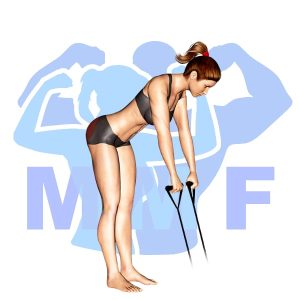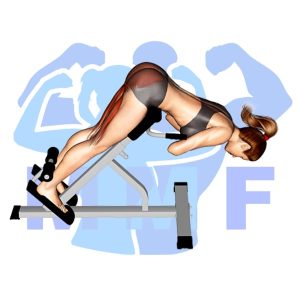Are you tired of suffering from lower back pain and weakness during exercises such as squats or deadlifts? If so, you may be guilty of neglecting your lower back muscles. It’s a common issue and can cause injuries if ignored. But don’t worry, the solution is pretty simple. In this blog post, we’re going to dive into the benefits of incorporating resistance band hyperextensions into your workout routine. By doing so, you’ll strengthen your lower back muscles, and reduce the risk of injury during your compound exercises.
Resistance Band Hyperextensions Summary
- Primary Muscles: Erector Spinae
- Secondary Muscles: Gluteus Maximus, and Hamstrings
- Equipment: Resistance Band and Door Anchor
- Mechanics Type: Isolation
- Force: Pull
- Utility: Auxiliary

Resistance Band Hyperextensions Instructions
- Attach the resistance bands to your anchor point near the floor such as the bottom of a door.
- Grab the handles with both your hands while facing towards your anchor point.
- While bending at your hips and with your arms extended towards the anchor point come to the starting position.
- You should be stretch out from your but through your arms to the anchor point. If the bands are too loose, take a step or two back until they are taut
- Now execute the hyperextensions by pulling your back up by squeezing your lower back and glutes.
- Once your body is fully standing straight pause.
- Next, slowly lower your chest and arms back to the starting position.
- Repeat these hyperextensions for 8-12 reps.
Video Tutorial
Resistance Band Hyperextensions Muscles
Target (Agonist)
Synergists
Dynamic Stabilizers
- None
Stabilizers
- Latissimus Dorsi
- Levator Scapulae
- Rhomboids
- Trapezius – Lower
- Trapezius – Middle
- Trapezius – Upper
Antagonist Stabilizers

Benefits of Resistance Band Hyperextensions
Resistance Band Hyperextensions are a great exercise to include in any strength training or fitness routine. This exercise is beneficial for strengthening the lower back muscles, especially the Erector Spinae. This exercise will help increase the strength and stability of the spine and improve overall posture. Additionally, Resistance Band Hyperextensions can help to reduce lower back pain as well as improve balance and coordination. By using a resistance band, the exercise can be done with greater range of motion and focus on specific areas that need more attention. Resistance Band Hyperextensions are an excellent exercise to strengthen the muscles of the lower back and improve overall fitness.
Tips for Performing Resistance Band Hyperextensions
If you would like to attain the most beneficial outcomes, stick to these simple and easy tips. Also, if you would like to avoid injuries, stick to these tips.
- Ensure The Resistance Band Are Strained. Before you start the workout ensure the bands are not hanging.
- Perform The Appropriate Quantity Of Sets With Rest. Your goal initially should be to do 3 sets to near fatigue. However, you can increase to 5 sets. If your muscle tissue isn’t exhausted at the conclusion of 3 – 5, something should change. Initally, you can increase the resistance to make each rep harder. Additionally, you can cut down on the rest time in between each set.
- Make Use Of A Mirror To View Your Technique. You might think you are a little vain looking in a mirror while you are working out, but you are not checking yourself out, you are making certain your technique is good.
- Focus On Inhaling And Exhaling. With this and most workouts inhaling and exhaling is very important. You should be breathing out during your target muscle flexing and breathing in when your target muscles are relaxing.
- Maintain Your Stomach Tight. For most exercises, you will need to reinforce your back by flexing your stomach to raise your inner pressure all around your backbone.
Benefits and Tips Video
Frequent Mistakes To Avoid
You should avoid these standard mistakes to manage ideal form and muscle growth. Furthermore
- Don’t relax your core. Flexing your stomach protects your backbone by maintaining your internal pressure.
- Don’t Cheat. Most of the time, cheating is utilizing momentum instead of the strain of your primary muscle tissue. Once in a while, a bit cheating on your final rep can be great to overload your muscle, but not for more than a few reps.
Find More Resistance Band Exercises Here
Variations and Complementary Exercises
If you’re looking for a variation on the Resistance Band Hyperextensions exercise, or are looking for exercises that work similar muscles, there are several other exercises that may be of interest. Below is a list of complementary, alternative, and variations of the Resistance Band Hyperextensions exercise.
Resistance Band Hip Extensions

Resistance Band Hip Extensions are a great complementary exercise to Resistance Band Hyperextensions. This exercise focuses on the hip flexors and strengthening the glutes. It is a great alternative exercise to build strength in the lower back and hip region, while still targeting the same muscle group as the Hyperextensions. This exercise can be done with a band looped around both legs and pulled tight, or with a single band looped around one leg and pulled tight. This exercise can be done while seated or standing, depending on the level of resistance needed. Resistance Band Hip Extensions are an effective way to target the hip flexors, glutes, and lower back, making them a great alternative to Resistance Band Hyperextensions.
45 Degree Hyperextension

45 Degree Hyperextensions are an excellent complementary or alternative exercise to Resistance Band Hyperextensions. 45 Degree Hyperextensions can target the same muscle groups as Resistance Band Hyperextensions, but with a slightly different angle of attack. This exercise requires the user to lean forward from the waist, holding the weight plate in both hands behind the head. The individual then pushes back, extending the arms and torso until the arms are fully extended and the back is parallel to the floor. 45 Degree Hyperextensions offer a great way to strengthen the lower back, glutes, and hamstrings, making it an excellent alternative or complementary exercise for Resistance Band Hyperextensions.
Straight Leg Cable Pull Through

Straight Leg Cable Pull Throughs are a great alternative or complementary exercise to Resistance Band Hyperextensions. This exercise focuses on strengthening the hamstrings, glutes, and lower back, and can be done with a cable machine or resistance bands. To perform the exercise, stand a few feet away from a cable machine or resistance band and grab onto the handle or band. Keeping your legs straight and slightly bent at the hips, pull the handle or band towards you while squeezing your glutes and keeping your core engaged. This exercise targets the same muscles as Resistance Band Hyperextensions, but in a different way, making it an excellent addition to any lower body routine.
Check Out These Top Resistance Band Exercises
Bird Dog Plank

Bird Dog Plank is an excellent complementary exercise to Resistance Band Hyperextensions, as it works similar muscles while also strengthening the core. It involves getting into a plank position on the hands and feet and then raising one arm and the opposite leg off the ground. This exercise works the back, glutes, and core muscles, and provides a great way to increase stability and balance. It is also great for those who are looking for an alternative to Resistance Band Hyperextensions, as it helps build similar muscles without putting too much strain on the lower back.
45 Degree Twisting Hyperextension

The 45 Degree Twisting Hyperextension is a great complementary or alternative exercise to Resistance Band Hyperextensions. It is an advanced exercise that targets the glutes, hamstrings, lower back, and core. To perform this exercise, you will need a 45-degree hyperextension bench and a weight plate. The movement begins with you lying face down on the bench, feet firmly planted on the foot plate and hands on the handles. You will then slowly raise your torso up and twist to one side while keeping your hips flat against the bench. You will then lower your body back down and twist to the other side while keeping your hips flat against the bench. This exercise is great for building strength, stability, and balance throughout your entire body.
Cable Glute Kickbacks

Cable Glute Kickbacks are a great complementary or alternative exercise to Resistance Band Hyperextensions. This exercise focuses on the glutes and hamstrings and is an excellent way to increase strength and stability in the lower body. To perform the Cable Glute Kickbacks, you will need a cable machine with a low pulley and an ankle strap. Attach the ankle strap to the pulley, then stand with one foot on the cable and the other foot flat on the floor. With your back straight and core engaged, slowly kick your leg back until it is parallel to the floor, then return to the starting position. This exercise should be performed slowly and controlled to maximize results.
Find More Lower-Back Exercises Here
Opposing Complementary Exercises
To enhance the effects of Resistance Band Hyperextensions, it is important to work the opposing muscle groups as well. Below are a few exercises that will help strengthen your back, glutes, and hamstrings for greater stability and balance:
Hip Thrust Crunch

Hip Thrust Crunch is a great complementary exercise to Resistance Band Hyperextensions as it works the opposing muscle group. Hip Thrust Crunch targets the hip flexors and core muscles, helping to strengthen and stabilize the lower body. This exercise involves lying on your back with your knees bent and feet flat on the floor, then pushing your hips up off the ground and crunching your torso into a seated position. This movement works the abdominals, obliques, and hip flexors, while also engaging the glutes to help stabilize the body. Resistance Band Hyperextensions, on the other hand, target the glutes and hamstrings, helping to develop strength in the lower body. Combining these two exercises together can help to build overall balance and stability throughout the entire body.
Hip Lift

Hip Lifts are a great way to complement the exercise Resistance Band Hyperextensions, as they work the opposing muscle group. By doing the Hip Lift, you are working your lower back, glutes, and hamstrings, which are the opposite of the muscles that are being worked in the Resistance Band Hyperextensions. This allows for a complete and balanced workout, as the opposing muscle groups are being worked simultaneously. This helps to create a more efficient and effective workout overall, allowing for greater gains in both strength and flexibility.
Bridge On Knees

Bridge On Knees is a great way to complement Resistance Band Hyperextensions and build strength in the glutes and hamstrings. By using the opposing muscle group, Bridge On Knees helps to strengthen and stabilize the back, as well as increase flexibility in the hips and spine. This exercise helps to create balance in the body, which is important for maintaining healthy posture and preventing injury.
Transform Your Lower Back with Resistance Band Hyperextensions
If you’re looking to tone and strengthen your lower back, resistance band hyperextensions are a great exercise to add to your routine. By performing these movements, you engage your glutes, hamstrings, and lower back muscles, creating a well-rounded workout for your posterior chain. Resistance band hyperextensions also improve your posture and help alleviate any lower back pain you might be experiencing. Make sure to keep your movements slow and controlled, and always use proper form to prevent injury. With consistent practice, you’ll start seeing the benefits of this exercise in no time.
References: Wikipedia | ExRx.net | PubMed.gov | Comprehensive List of Lower-Back Resistance Band Exercises

